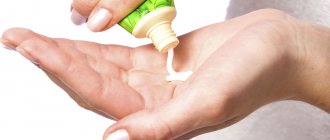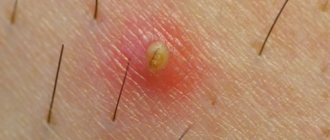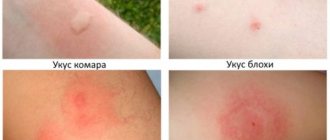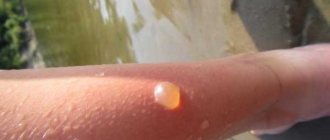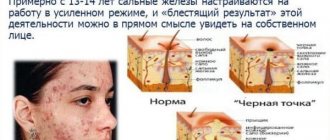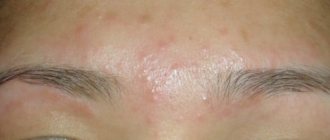Types of rash
Pimples on the pubis can have different structures, colors and shapes. These characteristics say a lot about the nature of their occurrence.
An experienced specialist can find out what exactly triggered the occurrence of such a problem, and anyone who has encountered this symptom should visit it.
Minor rash
Such a symptom usually indicates infection with an infection that is transmitted during intimate intimacy with its carrier. These pimples are characterized by their small size. Sometimes they resemble small blisters, the skin around which becomes very swollen and itchy.
Red rashes
If the skin in the pubic area suddenly turns red, it is possible that it was susceptible to fungal infection. This disease is characterized by fairly large pimples with clear outlines around the edges.
In addition, the patient will notice severe peeling and slight swelling on the skin. Also, blisters may form on the pubis, which are filled with a small amount of pus.
Redness, accompanied by pimples, often worries young people during adolescence. Sometimes it goes into the acne stage.
It is worth noting that this symptom often occurs due to non-compliance with personal hygiene rules and prolonged wearing of too tight clothes, which quickly irritate the skin.
Itchy rash
If the pimples begin to itch very much, then we can talk about skin damage in the pubic area due to various pathological processes. Quite often, malaise occurs due to the following diseases:
Itchy skin should never be scratched, as this can lead to damage and infection.
Rash after shaving
Those who practice shaving know that after these manipulations, wounds may remain on the skin. This is especially unavoidable if you use a dull razor. The resulting wounds must be treated with any available antiseptic.
This measure will prevent them from becoming infected.
Causes of rash in adults and children
A red rash on the pubic area can appear not only in an adult, but also in a small child. It is immediately worth noting that it does not always indicate the development of a pathological process on the surface of the skin or inside the body. However, with such a symptom, it would not be superfluous to check with a doctor.
Rash in men
Men may experience this symptom for various reasons. Most often it occurs due to the following diseases:
- Pediculosis pubis;
- Psoriasis;
- Ringworm;
- Venereal diseases.
It is possible that the pimples are the result of an allergic reaction to a certain irritant that recently affected the man’s body. Most often, the allergen is a food product or component present in men's cosmetics or household products.
Rashes in women
Women and girls often experience pimples on their pubic area after improper shaving. They themselves are caused by an inflammatory process that takes place in the hair follicles.
Avoiding such troubles allows you to follow the rules regarding skin care and removal of unwanted hair on the body.
Quite often, girls develop painful wen on their pubic area. They are caused by blockage of the sebaceous glands. Their removal is best done surgically. Do not forget that pubic pimples often appear due to lice infestation. In this case, the symptom will be supplemented by pustules and severe itching.
Rashes in children
An unpleasant sore can occur in a child at any time. It is usually associated with viral diseases to which children's bodies are highly susceptible. In such cases, pimples will be accompanied by signs of a cold.
Pimples often appear on the pubic area, as on other parts of the body, when a child has measles or rubella. If parents do not carefully monitor their baby's nutrition, they may be triggered by a food allergy.
Herpes on the pubis during pregnancy
It is generally accepted that pregnancy cannot provoke activation of the herpes virus. Some scientists disagree with this opinion.
If a woman is a carrier of HSV, then in most cases pregnancy and childbirth occur without consequences. Treatment of herpes is prescribed only in case of external manifestations of a systemic disease, such as hepatitis, meningitis and others. Such complications are typical for women who first become infected with the virus while carrying a child. Treatment, as a rule, involves taking the “Acyclovir” described above.
If timely treatment is not carried out, viral cells can penetrate the placental barrier and infect the fetus. Against the background of such a lesion, developmental defects occur in the first trimester, then the mucous membranes, skin, eyes, brain and liver of the unborn child become infected. In this case, a frozen pregnancy can be determined.
HSV increases the risk of premature birth. A child born from a mother with an active virus may experience cholioretinitis, microcephaly and microophthalmia.
If the virus is in an inactive phase, then natural childbirth is allowed, without cesarean section. Rashes in the genital area are a reason to refuse natural childbirth. If a woman does not have antibodies to herpes, she is recommended to use Acyclovir at the planning stage of pregnancy to avoid transmitting the virus to the child.
Activation of the virus in the prenatal period can lead to placental abruption, as well as weak labor. Such a patient requires increased medical attention. Doctors recommend checking for antibodies to the herpes virus in preparation for conception.
Rash as a symptom of a sexually transmitted disease
Above, the topic was superficially touched upon that spots in the pubic area in men, as well as women, can appear due to infection with a sexually transmitted disease. Such diseases are transmitted during intimacy.
Pimples may indicate a number of sexually transmitted diseases:
If a man or woman suspects that pimples in the intimate area are the result of sexual intercourse with a carrier of the infection, they should immediately visit a specialist’s office.
Pharmaceutical preparations for the treatment of rashes on the pubis
Depending on the results of the tests, the doctor will prescribe a topical ointment to the patient. He can offer:
The active components of these ointments have an effect on the lesions. They prevent the formation of new pimples and relieve itching and swelling. Also, after using them, irritation disappears.
A pink spot on the pubic area or numerous pimples may be the result of reduced immunity. That is why the disease was able to easily infect the body. In this case, it is worth using drugs.
Athlete's groin is a chronic disease caused by a fungus that affects the epidermal layer of skin mainly in the groin area. The main morphological element of the pathology is a scaly pink spot with pustular rashes located along the periphery.
The lesions itch and cause discomfort to patients. Athlete's groin is a delicate disease that leads to sexual dysfunction, decreased libido and sexual arousal.
The disease affects men more often than women. In children and adolescents, the pathology develops extremely rarely. The spread of fungal infection occurs through household contact through direct contact, through household items, personal hygiene products, and cosmetics. With a decrease in the general resistance of the body, a primary focus is formed at the site of entry of the pathogen, which gradually grows along the periphery and spreads to healthy skin. The main location of the fungus is the inguinal folds.
In more rare cases, the disease can affect the skin of the buttocks, scrotum, perineum, penis, inner thigh, and pubic area. In women, the skin under the mammary glands, in the armpit and popliteal fossa often becomes inflamed.
Fungi of the genus Epidermophyton floccosum settle in the epidermis of the skin, destroy and utilize collagen, which leads to a decrease in the elasticity of the skin. Microorganisms have a low degree of pathogenicity, so the disease rarely develops in healthy people with full immune protection.
The diagnosis of pathology is made after microscopic detection of fungal mycelium in scrapings from the surface of spots and obtaining the results of bacteriological examination of biomaterial from patients.
Groin fungus requires a patient and careful approach. Causal treatment involves the use of antimycotic drugs that can completely cure the disease.
What are the dangers of pubic acne?
Pimples on the pubis do not pose a specific danger to the life of the patient, but the occurrence of conditions associated with health risks cannot be ruled out. In particular, the rash is threatened by the presence of other infections and bacteria in the body against the background of insufficient immunodeficiency. The simplest manipulation of lesions using external medications will prevent the development of microbes and provide protection against the following consequences:
- transmission of harmful bacteria to loved ones through household means;
- development of oncology and adhesions in the genital organs in women;
- in case of acne formation on the mucous membrane of the groin, urinary retention is possible;
- infections affect the central nervous system;
- the occurrence of sexual ailments.
Sexual intimacy between an infected partner and a healthy partner contributes to the spread of viruses. During the period of possible transmission of the disease, any contact is prohibited.
A rash on the pubis can be the result of minor malfunctions in the body, and can also be a symptom of dangerous diseases. You can read more about this. Self-medication is not recommended. You should consult a dermatologist or gynecologist. Properly prescribed therapy will help you get rid of acne quickly and without consequences.
Any changes in the skin in the groin area can cause concern about your health. Darkening of the skin in the groin in men can be caused by various internal and external factors. Usually a man notices that his skin tone has become darker during hygiene procedures. Representatives of the stronger sex do not attach such great importance to such cosmetic defects, therefore, unlike women, they may not pay attention to darkening of the skin in the groin.
However, in some cases, age spots in the groin and changes in skin color may signal the development of the disease. Therefore, you should not ignore this sign and seek advice from a dermatovenerologist.
Some reasons that cause darkening of the skin in the groin or the appearance of age spots are in no way related to the occurrence of pathological processes in the body and can be easily corrected. These reasons include:
- Trauma due to depilation: many men remove excess hair from the pubic area and scrotum area. Microtraumas caused by razor cuts can lead to darkening of the skin in the groin area. After waxing, ingrown hairs into the skin are often observed and, as a result, the appearance of dark spots in the groin. To avoid such situations, you need to properly deal with hair growth in intimate areas; you should not remove hair in a hurry or use old razors. If you want to achieve longer-term results, then opt for sugaring or depilation in a salon. After the procedures, special products will be applied to the skin to prevent irritation and ingrown hairs;
- Poor quality or unsuitable underwear: although men are not fixated on the aesthetic characteristics of underwear, when purchasing, be sure to pay attention to its material. The quality of the seams is also important. Synthetic and too tight underwear increases sweating in the groin area, which leads to darkening of the skin in the groin. Trauma due to constant friction also leads to a change in the color of the skin of the groin area;
- Incorrect tanning: while relaxing on a nudist beach or tanning in a solarium, do not forget about protecting the delicate skin of your intimate areas from ultraviolet radiation. Pigment spots in the groin in men can be a consequence of excessive exposure to the sun. Due to disturbances in the metabolism of melanin, areas of hyperpigmentation appear on the skin;
To eliminate the above factors, you just need to slightly change your lifestyle and some of your habits. However, darkening of the skin in the groin and age spots can also be symptoms of certain diseases:
- : a skin disease caused by the fungus Epidermophyton floccosum. Men are more susceptible to this fungal skin infection. Infection occurs directly from a sick person or through underwear and intimate toiletries. Excessive sweating is considered the main predisposing factor in the occurrence of athlete's foot. Due to constant humidity, maceration of the epidermis occurs and the pH of the skin changes. The main clinical manifestation of the disease is dark pink pigment spots in the inguinal folds. In addition to changes in the skin, men complain of severe itching;
- Development of a malignant neoplasm in the stomach: one of the symptoms is dark spots in the groin in men. A characteristic feature of such stains is their dense, velvety surface. If you have signs such as weakness, lack of appetite, frequent mood changes, as well as regular discomfort in the epigastric region, you should contact a gastroenterologist and undergo the necessary examination;
- Pathologies of the liver and gallbladder: insufficient secretion of bile into the gastrointestinal tract due to congestion in the liver can lead to darkening of the skin in the groin area. Typically, liver diseases are accompanied by severe disturbances of digestion and general well-being;
- Endocrine diseases: the appearance of dark spots in the groin can be caused by Cushing's disease or syndrome, as well as Addison's disease. The occurrence of these pathologies is based on dysfunction of the adrenal cortex and hormonal metabolism. In patients suffering from Addison's disease, in addition to the groin area, the nipples and axillary area are involved in the pathological process;
- Chronic poisoning: some substances tend to gradually accumulate in the skin and change their color. The risk group consists of men whose professional activities are closely related to the use of chemicals and heavy metals;
If darkening of the skin is accompanied by any problems with your general condition, you should immediately seek medical help. Ignoring this symptom can lead to serious consequences for your health.
Etiology
Athlete's foot is a dermatomycosis caused by the fungus Epidermophyton floccosum. This is an anthropophile that grows and develops only on the human body. It is located in the scales of the epidermis and nail plates. Under a microscope, fungal spores and well-branched mycelium are determined in skin scrapings. After isolating a pure culture, the mycelium becomes yellow and the spores look larger.
Fungi are resistant to environmental factors. They grow and develop quickly at high humidity and temperature.
The infection spreads through contact and household contact through contaminated household items, as well as through touching and shaking hands. For rapid growth and development of fungi, moisture is necessary. Excessive sweating in a patient significantly increases the risk of infection.
In medical, preventive and public institutions, neglect of sanitary norms and rules can provoke an entire epidemic of mycosis.
Factors contributing to infection:
- Hyperhidrosis,
- Stress,
- Skin microtraumas
- Tight clothes,
- Obesity,
- Failure to comply with sanitary rules and regulations,
- Decreased immunity
- Hormonal disbalance,
- Metabolic disorders.
Symptoms
single spot of athlete's foot
With inguinal athlete's foot, pink or red-brown spots appear on the skin, having a round shape and a diameter of no more than one centimeter. The spots are located symmetrically, itch, peel and gradually grow. Along the periphery of the spot on hyperemic and edematous skin, multiple blisters, pustules, suppurations, crusts and small flaky inclusions appear. Foci of inflammation are limited to an edematous ridge. Plaques can merge with each other, forming a single erythematous area that spreads to surrounding tissues. Itching and burning are especially felt when walking, squatting and while bathing.
As the inflammatory process subsides, the central part of the spot becomes clean, pale and slightly sunken. This gives foci of epidermophytosis a special appearance of rings and is a pathognomonic sign of pathology. Fungus in the groin in men itches and burns, and severe discomfort occurs when walking. The areas are painful to the touch. Vesicles and pustules can burst, forming erosions and ulcers. When a secondary bacterial infection occurs, severe complications develop.
Photo: inguinal athlete's foot in men and women
Additional symptoms of athlete's foot include swelling of the groin area, hyperemia of nearby skin, and the appearance of specific blisters with turbid serous fluid. With epidermophytosis, not inflammatory, but allergic rashes - epidermophytide - may appear on the skin. They are located symmetrically, do not contain fungi and disappear on their own after undergoing antimycotic treatment.
In the absence of timely and adequate treatment, the disease can last for years.
Athlete's disease is characterized by an acute or subacute course with pronounced signs of inflammation. The disease quickly becomes chronic and takes on a wave-like course, during which periods of remission are replaced by exacerbations, forming from time to time new foci of skin lesions. Even after complete recovery, the disease can recur.
Constant stress, friction in the affected area and hyperhidrosis complicate the course of the pathology.
Treatment methods for scabies on the genitals and buttocks
Scabious scabies is established on the basis of:
- clinical data (presence of itching and nodular rash on the pubis and genitals);
- collecting patient complaints;
- epidemiological information (stay of a person in the epicenter of the epidemic, examination of contact persons);
- a blood test, in which the number of lymphocytes may increase with nodular scabies;
- laboratory diagnostics;
- differential diagnosis.
“Venereal” scabies itself, so called because of its location, does not go away and requires careful treatment, as it can become chronic. For drug therapy, it is recommended to use:
- Antiscabiotic drugs (for example, benzyl bezoate ointment, sulfur-tar ointment, Lindane and others);
- Corticosteroids and antihistamines:
- antiallergic - “Suprastin”, “Tavegil”, etc.;
- antiseptics and antibacterial agents;
- in case of widespread rash, calcium supplements and zinc ointments are prescribed;
- hormonal agents against itching and inflammation (for example, Sinaflan).
- In case of complications in the form of pustular lesions, scratching areas are treated with antiseptics, sulfonamides and antibacterial agents (Fukortsina, Gioksizona).
“Venereal” scabies, in addition to medications, can also be treated with laser therapy.
If the nodules persist for a long time, then treatment with liquid nitrogen, laser therapy, leeches, and diathermocoagulation is possible. Recovery is possible in two weeks, but may take several months. Therefore, the patient is examined every 10 days throughout the course of treatment. During treatment, you should remember the following rules:
- everyone in the affected area should undergo treatment;
- nails should be trimmed to avoid scratching knots;
- a prerequisite is a warm shower with soap and a washcloth to mechanically remove some of the ticks;
- apply all medications with bare hands;
- do not forget about processing things that came into contact with the affected areas;
- strict compliance with all doctor’s prescriptions.
Itching in the intimate area is possible with some systemic diseases, including renal failure, cholestasis, hematological disorder or malignancy.
It is considered a secondary condition and the diagnosis is made based on the entire clinical picture.
It is difficult to calculate the disease if itching of the vagina and labia is the only symptom.
A gynecologist can conduct the following tests:
- Vaginal examination.
- Swabs from any location—samples are analyzed under a microscope to detect the presence of organisms associated with intimate area infections.
- Pap test to rule out cervical cancer.
- DNA-based tests are quite accurate for diagnosing vaginal infections.
- Colposcopy or biopsy - if the cervix looks abnormal.
Stages of the disease
- The initial stage is characterized by increased proliferation of the fungus in the epidermis and the appearance of pink spots with papules and vesicles on the skin.
- Clinical signs of the acute stage are weeping spots that grow, itch and are replaced by rings with scalloped edges.
- Chronic stage - lesions on the skin periodically lighten, and then become inflamed again under the influence of unfavorable factors.
- The advanced stage develops with a complicated course of the pathology. If left untreated, large blisters appear on the skin, which become infected when damaged. The blisters are opened, necrotic tissue is removed and the wound is treated.
Diagnostics
Diagnosis and treatment of fungus in the groin area is carried out by dermatologists and mycologists.
After collecting a history of the disease and listening to the patient’s complaints, they begin an external examination of the lesion and laboratory research methods. In some cases, consultation with an infectious disease specialist, venereologist, or immunologist may be required.
To confirm or refute the alleged diagnosis, it is necessary to conduct a microscopic and bacteriological examination of scrapings from the lesions for pathogenic fungi. To do this, prepare a smear for microscopy and inoculate the test material on Sabouraud’s selective medium. The crops are incubated in a cooling thermostat at 22 degrees for 5 days. Saburo produces cream or yellow colonies with a round shape and fluffy consistency. Microscopy reveals septate branching short mycelium and chains of rectangular spores.
Examination under a Wood's lamp will help exclude other diseases with a similar clinical picture.
Treatment
Treatment of inguinal athlete's foot is predominantly etiotropic.
Since the disease is fungal, it is necessary to start taking
antifungal drugs
. Currently, the pharmaceutical industry produces a large number of effective ointments and creams. Modern antifungal drugs - Lamisil, Mycoseptin, Clotrimazole. You can use Nystatin, Ciclopirox, Ketoconazole, Oxiconazole, Econazole. Complex ointments with an antifungal component and glucocorticosteroids are used in especially advanced cases. They have a pronounced antipruritic, fungicidal, drying and antiseptic effect.
Treatment of inguinal fungus is carried out in the acute period, when the patient suffers from itching and burning. Antihistamines come to the rescue
that eliminate irritation and discomfort in the groin - “Cetrin”, “Zyrtec”, “Zodak”, “Diazolin”.
After eliminating the symptoms of inflammation, the foci of epidermophytosis are treated with a Fukortsin solution, which has a fungicidal and antimicrobial effect. Patients are prescribed lotions with Resorcinol, sulfur-tar, Wilkinson and zinc ointments, Triderm. A silver solution will help cope with inflammation and serous blisters. Local preparations are applied to inflamed areas 2 times a day. If the blisters reach large sizes, they are opened with sterile instruments. Fungus in the groin should be treated for a long time, until the symptoms disappear completely.
During illness, the patient's immunity is greatly reduced. To strengthen it, it is recommended to use mild immunostimulants
- “Immunal”, “Imunorix”, “Licopid”. Complications of bacterial origin require treatment with antibiotics.
In the presence of extensive lesions, desensitizing therapy, antibiotic therapy, vitamin therapy, and autohemotherapy are carried out in a hospital setting.
If personal hygiene is not observed, drug treatment does not give a positive result. Patients need:
- Wash daily, paying special attention to the treatment of skin folds;
- Take baths with infusions of medicinal herbs that have anti-inflammatory and antiseptic effects;
- Wear loose underwear made from natural fabrics.
ethnoscience
Currently, there are a large number of traditional medicine recipes intended for the treatment of inguinal epidermophytosis at home.
How can you reduce irritation?
Genital scabies in adults disrupts the usual way of life, as a result of which a person cannot sleep normally and becomes irritable. To reduce unpleasant itching sensations, it is necessary to regularly carry out water procedures 2-3 times a day, using well-heated water. It is recommended to add chamomile decoction or furatsilin to it to relieve inflammation.
If you have scabies accompanied by severe itching, you should exclude spicy and sour foods and alcohol from your diet. It is also necessary to use underwear made from natural materials, avoid hypothermia, and do not use pads every day.
Important! To prevent infection, you should regularly visit a urologist and gynecologist.
Prevention
Preventive measures to avoid the appearance of fungus in the groin:
- Disinfection of patient care items and common areas,
- Boiling and ironing linen, socks, shoe treatment,
- Use of removable shoes in baths and saunas - slates or rubber slippers,
- Fighting sweating
- Regular hygiene procedures,
- Wearing underwear made from natural fabrics in hot weather,
- Daily treatment of skin folds with cologne, salicylic alcohol, resorcinol and powdering them,
- Examination of contact persons,
- Prevention of stress,
- Strengthening the immune system.
Without adequate treatment, the spots will not disappear, and the disease will only progress. At the first symptoms of inguinal athlete's foot, you should consult a specialist. Pathogenic fungi and foci of epidermophytosis on the skin grow rapidly.
The prognosis of the disease is favorable. Acute and chronic stages of inguinal athlete's foot respond well to therapy. Modern antimycotic drugs can prevent relapse and re-infection.
There are many factors that cause pubic acne. They need to be dealt with as soon as possible. There are also several diseases that are indicated by the appearance of pubic acne.
Depending on the symptoms and nature of the rash, the root cause of the phenomenon can be determined. For clarity, it is recommended to familiarize yourself with the photos of the manifestations.
Rash symptoms
Depending on the time of detection of the disease and the moment of infection, its two stages are divided:
- initial;
- recurrent.
At the initial stage, the affected area turns red, slight itching appears, swelling of the genitals and enlarged lymph nodes are possible, and in some cases, fever. Some diseases cannot be cured completely, so a relapse occurs with weak immunity, stress and colds. The rash develops faster and more intensely and does not go away for several weeks. The wounds do not heal, and the pain intensifies. Over time, the bubbles burst and liquid oozes out.
Causes
If acne appears on the pubic area, then first of all it is important to understand why this happened. There are different kinds of reasons. Some of them relate to harmless processes occurring in the body and such formations do not pose any health hazard; however, sometimes pubic acne appears due to the development of certain diseases.
In such a situation, it is worth paying closer attention to the manifestation and determining treatment; it is recommended to consult a doctor.
Natural processes
Natural processes primarily include changes in hormonal levels, which are characteristic of adolescents and occur in women during pregnancy or during menstruation.
White pimples on the pubic area appear due to the fact that the sebaceous glands work harder after a hormonal imbalance has occurred. A rash in the intimate area appears in men, women and adolescents if intimate hygiene is not observed and tight clothing made of low-quality materials is worn.
It is also not uncommon for pimples to pop up after shaving. This phenomenon is explained by the fact that the skin in the groin area is very thin and sensitive, it is exposed to various unfavorable factors and many of them contribute to the appearance of both acne and the penetration of infectious microflora into the subcutaneous layer.
Despite the fact that such phenomena are not harmful to health and do not require special treatment measures, it is not recommended to eliminate them on your own. In particular, open them with needles or any other sharp objects. After opening, pathogenic microflora can easily enter the wound and provoke the appearance of even more pustules.
These pimples are often itchy and painful. The formation of purulent pimples on the pubis occurs due to a weakened immune system or after some stressful factor for the body, for example, severe hypothermia or a previous illness. Boils, even small ones, can cause significant discomfort.
They are red in color, and swelling and pain appear on the skin at the site of the rash. Additional symptoms of furunculosis are chills and an abrupt increase in body temperature.
This condition is also not too dangerous, especially if you promptly treat the affected area of skin with an ointment that contains antibiotics and take a course of immunomodulatory drugs along with vitamin and mineral complexes.
If a pimple appears under the skin in the bikini area, in particular on the labia of women, then this requires the intervention of a doctor. The pathological condition is caused by the formation of a cyst on the sebaceous glands. A subcutaneous pimple grows over time, hurts and causes serious discomfort.
Diseases and treatment
There are several standard measures that will help remove watery, small purulent pimples from the skin that appear due to provoking factors or natural processes occurring in the body.
- Before going to bed, treat the affected area of skin with Vishnevsky ointment or use Levomekol. This area is covered with gauze from above and removed after waking up;
- If one large pimple appears, then you can attach a fresh aloe leaf to it. It is enough to apply the plant 3 times and leave for several hours for the pimple to disappear;
- Cauterization with iodine is highly effective;
- A good way to get rid of pubic pimples is to take a shower and then treat the affected area of skin with hydrogen peroxide.
Rashes on the pubic area: common causes
There are at least five reasons for the appearance of a rash on the pubis and genitals in men.
They can be called the most common and the most serious. There are a number of reasons of a more banal nature, but they will be discussed a little later.
Thus, a rash on the genitals and pubic area is often accompanied by a disease such as lice pubis. Its other name is phthiriasis, although this disease is popularly called pubic lice. This is a contagious disease that is transmitted from one infected pubic area to another. Direct or indirect contact with an infected person is necessary. In men, pubic lice are located directly in this area, as well as in the scrotum area.
Very rarely they appear on the genitals of men, since they prefer more “secluded” and warmer places. It is the bites of hated lice that cause rashes and redness on organs and adjacent areas. Later, the bites turn red, and if left untreated, the rash turns into ulcers. If they are not treated, this can end very badly and seriously.
Psoriasis is another cause of rashes affecting the pubic area in men. It must be said that this disease is chronic. Most often it is hereditary, but it can be acquired, since in this case the psychological and nervous factor is of great importance. The psoriatic rash has a wave-like character: it appears and then disappears. How to deal with psoriasis? You need to constantly fight it so that it does not develop into a more advanced stage, but it will not be possible to completely cure the disease. Periodically he will remind himself.
A disease such as dermatitis has approximately the same wave-like character. As a rule, people suffering from dermatitis experience the onset of the disease from time to time throughout their lives. It is, of course, not as severe as psoriasis, but that doesn’t make it any less unpleasant.
The next cause of rash on the male genitals and surrounding area is ringworm.
Its other name is dermatophytosis. The causative agents of the disease are fungi. They quickly spread on the human body, creating enormous inconvenience to their “owner”. Conventionally, two stages of the disease can be distinguished in both men and women. There is a mild and severe stage. In the mild stage, redness is minor but noticeable. At a more severe stage, large red spots are observed, which, in the absence of therapy, quickly develop into ulcers with white contents. The spectacle is not for the squeamish.
Do not forget that any changes on the genitals and the area near them may indicate the presence of sexually transmitted diseases. This is what is important to check first. The first step is to undergo an examination by a dermatologist and venereologist. However, the activities of these specialists often overlap.
Pubic spots in men
In almost all cases, skin rashes indicate the development of an inflammatory process in the body. If red spots appear on your pubic area, you should consult a doctor. This is due to the fact that rashes in intimate areas often serve as a symptom of various ailments.
Less commonly, spots occur for a number of other reasons not associated with diseases. The doctor will conduct diagnostic measures and prescribe treatment based on the research results. Below are the most likely causes of red spots on the pubic area (a photo of the rash is presented below).
Ftiriaz
This term refers to a parasitic pathology that belongs to the group of sexually transmitted infections. Another name for the disease is pediculosis pubis.
Typically, lice are spread through close contact with an infected person. The risk group includes the following categories of people:
- Leading a promiscuous lifestyle.
- Adult film actors.
- Homeless.
- Workers of saunas, baths and dry cleaners.
- People who are serving sentences in prison.
- Workers of child care institutions.
- Military personnel who live in barracks.
It is important to know that from the area of primary infection, pubic lice can easily move to the intimate part of the body. As a rule, the pathogen affects the pubis, anus and perineum.
The main symptom of phthiriasis is severe itching. Red spots appear in places where scratching occurs. On the pubic area you can also notice a large number of skin flakes resembling dandruff.
The treatment regimen for lice pubis includes the use of insecticides that destroy lice, preventive measures and treatment of the skin of people who have been in close contact with the patient.
Psoriasis
This term refers to a dermatological disease that significantly worsens a person’s quality of life, especially sexual life.
The disease can develop for the following reasons:
- overstrain (both physical and mental);
- weakening of the body's defenses;
- disruption of the functioning of the organs of the reproductive system.
Genetic predisposition plays an important role.
The disease has specific symptoms. The main symptom is red spots on the pubis, covered with white scales. The boundaries of the rash are clear. In this case, patients are usually not bothered by itching.
With psoriasis in women, red spots on the pubis can be confused with vulvitis. They can also be located on the labia and mucous membrane. In this regard, if rashes appear, you should consult a gynecologist. Only a specialist will be able to carry out differential diagnosis and accurately determine the disease.
In men, spots can be localized not only on the pubis, but also in the folds of the groin and on the penis.
The treatment regimen for psoriasis includes the following points:
- Local application of hormonal ointments and creams.
- Taking antihistamines.
- Physiotherapy.
- A therapeutic diet.
Psoriasis is an autoimmune disease. This means that the disease is not transmitted to a partner through sexual contact.
Dermatophytosis
This is a pathology caused by mold fungi. The disease is most often diagnosed in men, women and children; the disease affects very rarely.
The infection is transmitted from animals, infected people and through the soil in which the pathogen lives. In this regard, the risk group includes the following categories of people:
- with a weakened immune system;
- paying insufficient attention to compliance with hygiene rules;
- regularly ride horses;
- agricultural workers;
- frequently using other people's personal items (for example, bath towels).
- Red spots on the pubis. In both men and women, they can be localized in the groin, thighs and buttock folds. The rashes are highly inflamed and symmetrical. The boundaries between them and healthy skin are roller-shaped.
- Pronounced itching and burning.
- Pustules and blisters often form.
To treat the disease, the use and external use of antifungal agents is prescribed. In addition, the skin must be treated with antiseptics. An important step in the treatment of dermatophytosis is regular adherence to hygiene rules.
Scabies
This is a parasitic disease, the causative agent of which can only infect the human body. The scabies mite can move from other parts of the body (from areas of primary infection), gnawing passages in the skin. But at the same time, the genital form of the disease often develops after sexual contact with an infected person.
The first alarming symptoms appear 3 days after infection. Clinical manifestations of the disease:
- Unbearable itching. Its severity increases in the evening and night hours.
- White or gray stripes on the skin are tick burrows.
- Red spots on the pubis, labia, scrotum, glans and foreskin of the penis.
Ignoring the disease leads to the development of complications, which are extremely difficult to get rid of. In this regard, it is necessary to promptly consult a doctor who will select the most effective anti-scabies.
Molluscum contagiosum
This term refers to a pathological condition of a viral nature. Both men, women and children are susceptible to the disease. The pathogen is transmitted not only during intimate intimacy, but also through contact and household contact.
The main sign of the disease is red spots on the pubis, scrotum, labia or penis. The rashes have the shape of a hemisphere. Often, nodules then form, and when pressed, a plug of curdled consistency emerges.
The red spots do not itch or flake, and they are also not painful. The genital form of the disease does not require treatment. In most cases, the rash disappears on its own within 2-3 months after its appearance.
If the spots are located in such a way that they are often injured, your doctor may recommend removing them in one of the following ways:
- curettage;
- cryodestruction;
- husking;
- laser excision;
- electrocoagulation.
Such treatment is carried out only in extreme cases. This is due to the fact that scars remain on the skin after the intervention.
Genital herpes
Carriers of the virus are 90% of the world's population. The pathogen, as a rule, is in a dormant form and is activated only when the body’s defenses are weakened.
Provoking factors are:
- hypothermia or, conversely, overheating;
- prolonged exposure to stress;
- venereal diseases;
- avitaminosis.
At the initial stage of development of the disease, a person’s body temperature rises, insomnia bothers them, sleep and appetite are disturbed. Then painful sensations arise in the intimate area and rashes appear.
Red spots on the pubic area itch, and a burning sensation is also bothersome. Gradually, bubbles filled with pathological fluid form at the site of the rash.
After about 5 days they open, and crusts form in their place.
Source: //medicskin.ru/pjatna-na-lobke-u-muzhchin.html
Groin rash in men: other causes
Previously, medical explanations for rashes in the groin and pubic area in men were presented. But we cannot discount ordinary everyday factors, which can also cause this inconvenience.
The issue may be in the cosmetics the man uses. Perhaps it causes allergies. If in any doubt, it is better to stop using cosmetics that cause the rash. In the future, it is better to give preference to hypoallergenic products.
It is also worth checking whether this reaction is caused by food allergens. The groin area is tender and sensitive, so it can be the first to respond to any factor disturbing the entire body.
Washing powder can also become a stumbling block. This is why many experts advise against washing your underwear with powders. For this it is better to use soap.
And since we’re talking about underwear, it’s worth saying a few words about it. For a considerable number of people, synthetic fabrics cause severe irritation to the skin. Still, the epidermis must breathe, especially such a sensitive one as in the groin area. The best underwear is natural. For example, made of silk or cotton.
These are the main factors that can initiate the development of a rash in the groin and pubic area in men. It is important to monitor your health and body in order to pay attention to any changes in it in time. This will help maintain health and well-being for many years!
One of the secondary signs of puberty is hair in the intimate area. They contain a lot of bacteria and various particles, so the intimate area needs increased care. Modern women try at all costs to get rid of unwanted hair, succumbing to frequent shaving or painful jerks of the epilator. Pimples can appear on the pubic area due to inflammation and an allergic reaction, and sometimes they spread along the thighs.
Mechanical damage to the intimate area leads to the fact that the upper ball of the skin, the epidermis, is affected. You can accidentally injure the mucous membranes of the genital organs. After getting rid of hair around the genitals, the skin swells, itches, and red pimples appear on the pubic area. It happens that such symptoms arise on their own when women carefully adhere to the rules of intimate hygiene. Sensitive skin or a bacterial infection may be to blame.
Having sought medical help, the patient receives an accurate diagnosis based on a visual examination and tests.
Causes of brown spots in the groin
So is it possible to get rid of stains or not? Today, social networks are actively discussing the transformation of a student who, in 30 days, completely got rid of the spots that covered her body from head to toe. How is this possible?
In practice, experts note several main reasons for the appearance of brown spots in the groin:
- age-related skin pigmentation;
- mechanical damage to the skin (cuts, scratches);
- diseases of internal organs (liver, cancer);
- hormonal imbalance;
- – erythrasma, epidermophytosis, .
Erythrasma
– a fungal disease that affects the epidermis of the skin in the groin area of men and women. Symptoms of erythrasma are brown spots in the groin, gray and yellow formations (sizing from 1-2 to 20 cm in diameter), itching, peeling and roughening of the skin.
The disease is caused by the fungus Corynebacterium minutissimum, which appears as a result of intense sweating, mechanical damage, and friction of poor-quality clothing and linen. The disease most often affects men.
Long-term treatment of erythrasma with the use of medications:
- tar and erythromycin ointments;
- 0,05%;
- salicylic alcohol 5%.
All drugs are used according to the instructions, on the recommendation of a dermatologist and mycologist.
Athlete's inguinal
- is a common fungal disease that affects the intergluteal and intergluteal. Rarely affects the skin of the hands and feet, and nails. Symptoms of athlete's foot: flaky burgundy, red and brown spots in the groin (2-3 cm to 15 cm in diameter), peeling skin, itching, soreness, etc.
Infection with this fungus occurs through tactile contact with a patient, dishes, clothing, linen and other household items. You can also get infected by visiting public places, such as a gym, swimming pool, sauna, etc.
It must be remembered that athlete's foot inguinal is provoked by obesity (over ten kilograms of your optimal weight), active sweating, and mechanical damage to the skin (scratches, cuts).
Treatment of erythrasma takes place at home using medications and traditional methods of treatment. As a rule, after detecting the first symptoms, the specialist prescribes:
- lotions based on a solution of silver nitrate 0.25%;
- cream, ;
- ointment;
- antihistamines;
- daily treatment of the affected skin with a solution of iodine and chlorhexidine.
Diseases that are accompanied by a rash in the intimate area
With a number of rather unpleasant diseases that are sexually transmitted, rashes appear on the pubis. Many people suffer seriously, wondering why they were diagnosed with a sexually transmitted infection if no one led a promiscuous lifestyle. Pathogenic pathogens can often be transmitted through household contact and pass unnoticed. Pimples on the pubis in men and women appear when the immune system is weakened.
The causes of rashes may include the following diseases:
- Genital herpes.
- Lice infestation.
- Molluscum contagiosum.
In the second type of herpes, which affects the genitals, watery pimples on the genitals resemble a labial cold. A fluid-filled blister appears on the genitals, which eventually bursts and turns into a painful ulcer. Pimples on the pubis are accompanied by itching, swelling, and sometimes the patient cannot sleep peacefully. An internal pimple on the pubis causes a lot of discomfort.
Such rashes are often accompanied by aching in the lower spine, lower back, nausea, and a feeling of fatigue. A sick person suffers from cutting pain during urination, sexual intercourse becomes impossible. White pimples filled with fluid appear on the genitals, internal genital organs, pubis, and may affect part of the thighs. If a person has ever had this type of herpes, with decreased immunity, hypothermia and stress, there is a high probability of relapse.
Features of pediculosis:
- the incubation period is four to five weeks
- very severe itching
- tingling sensation
- acne appeared in the perineal area and on the pubis.
Another disease that is sexually transmitted and also leads to the appearance of red pimples and rashes on the pubic area is genital herpes.
Molluscum contagiosum is a rather exotic disease. The causative agent is a poxvirus. It is transmitted sexually, as infection occurs only through close contact of the genitals. It affects the mucous membranes of the genital organs, the area near the anus and the perineum. After two months, characteristic rashes appear that look like a shiny pink papule. It does not hurt and practically does not itch. When the rash opens, a white mass is released that resembles cottage cheese. Having examined the unusual pimples on the pubis, photos of which are presented, you can draw the appropriate conclusions.
What to do if acne appears?
First of all, when pathological rashes appear, it is necessary to find out the cause. This is usually possible during an appointment with a dermatologist, which can be done confidentially if the patient wishes. Depending on the identified cause, appropriate treatment is prescribed, which may include the use of various groups of medications:
At some point, you may develop a lump or lump in your genital area. These bumps may be nothing, or their appearance may signal a more serious condition. If you are concerned, talk to your doctor. If you are a girl, you can ask your gynecologist. There are several lumps and lumps that cannot be ignored in the genital area.
Two types of lumps and bumps that you should not ignore are skin cancer and infections. Both can have serious consequences if you ignore them. There are also lumps in the genital area that are harmless and do not require treatment. Skin cancer is extremely rare in teenagers in the genital area, but not impossible. This type of skin cancer can be fatal if you don't get treatment for it.
- Antibiotics – designed to kill a bacterial infection, they are usually used in the form of a cream or ointment.
- Antiseptics - used for bacterial, viral or fungal infections, as they effectively destroy pathogens (hydrogen peroxide, chlorhexedine, brilliant green).
- Antihistamines - used to reduce the manifestations of an allergic reaction in the form of tablets or cream.
- Antiviral agents are necessary to destroy the virus during herpes infection; if molluscum contagiosum is diagnosed, radical removal of the formation is carried out.
- Insecticides are special products in the form of soap, spray or shampoos that destroy pubic louse and are used for pediculosis.
If a man is sure of the cause of acne in the pubic area, then he can begin treatment on his own. However, consultation with a dermatologist is recommended, since improper therapy can cause various complications.
It can be completely flat and can develop in the absence of sun. Infections that can have serious consequences if left untreated are genital warts, syphilis and possibly herpes. Genital warts are small, redness of the skin. They may eventually leave, stay in one place, or become more numerous. They are contagious and are caused by the genital human papillomavirus and are associated with cervical cancer in women.
If you think you have genital warts, you should see a dermatologist. Syphilis appears sick and may appear in the genital area or on the lips and mouth. They are bacteria, so they can be treated with antibiotics. It appears as if it were sick and will eventually go away within a few weeks. However, this does not mean that the infection has been cured, it is still there and needs to be treated. You can create serious problems if left untreated.
One of the secondary signs of puberty is hair in the intimate area. They contain a lot of bacteria and various particles, so the intimate area needs increased care. Modern women try at all costs to get rid of unwanted hair, succumbing to frequent shaving or painful jerks of the epilator. Pimples can appear on the pubic area due to inflammation and an allergic reaction, and sometimes they spread along the thighs.
Photo of peeling skin on the pubic area
You may also get hit in the genital area, which is harmless. These include cysts, angiomas and molluscums. Cysts are yellowish round lumps under the skin that resemble a small ball or pebble that can be easily moved around. They may increase slightly, but overall they remain approximately the same and do not cause any problems. They are usually caused by blocked hair follicles.
Peeling pubic skin photo
Angiomas are small collections of blood vessels and are either bright red or slightly purple. They usually do not enlarge or bleed. Molluscum is viral in origin, and in the genital area it is usually transmitted through sexual contact. Visit the American Academy of Dermatology's web page on Mollusca for more information.
Mechanical damage to the intimate area leads to the fact that the upper ball of the skin, the epidermis, is affected. You can accidentally injure the mucous membranes of the genital organs. After getting rid of hair around the genitals, the skin swells, itches, and red pimples appear on the pubic area. It happens that such symptoms arise on their own when women carefully adhere to the rules of intimate hygiene. Sensitive skin or a bacterial infection may be to blame.
They are usually colored and tiny. They will go away over time, but this can take up to three years. Although they do not cause any disease or increase the chances of cancer, they are a sexually transmitted disease and are usually a sign of unprotected sex.
With the exception of syphilis, these other diseases do not cause any shock to your genital area. People who are most likely to get sexually transmitted infections are people who have sex at an early age, have more sexual partners, and do not use a condom.
Having sought medical help, the patient receives an accurate diagnosis based on a visual examination and tests.
Non-infectious causes of rash
If acne appears in the intimate area, this may indicate improper depilation of the pubic area in women, poor personal hygiene, unsuitable underwear, or prolonged overheating of the genitals. Sometimes allergies to latex, detergents, scented pads, etc. occur, resulting in red pimples on the pubic area.
Another reason is the simplest failure to comply with personal hygiene rules.
Hormonal imbalances can often cause acne in people prone to endocrine diseases. Disturbances in neurohumoral regulation sometimes lead to systemic skin lesions.
When the level of estrogen decreases, they begin to form on the pubic region in women, which causes a lot of inconvenience. A significant role is played by skin characteristics, such as: increased oiliness, excessive sensitivity, poor heredity. A large pimple on the pubic area in women can occur at the site of a postpartum suture, which is accompanied by inflammation.
Among the pathologies of the endocrine system, the condition of the skin is affected by:
- Diabetes. In a chronic course, changes in blood glucose levels can lead to damage to the vascular walls and purulent-necrotic diseases (skin peels, wounds take longer to heal).
- Obesity. Overweight people tend to sweat more and develop sebum.
- Thyroid diseases. Affect metabolism in general. Purulent acne on the pubic area in women can occur if hypothyroidism is accompanied by a reduced amount of estrogen.
- Impaired secretion of glucocorticoids. These hormones normally have an anti-inflammatory effect. These hormones are sometimes prescribed to treat inflammation.
It happens that a bacterial infection is associated with mild inflammation. Most often, large purulent formations are caused by Staphylococcus aureus. An internal pubic pimple looks like a spot from the outside. Over time, a painful boil or carbuncle appears in its place.
If a purulent pimple pops up on the pubis, the cause may be simple excess weight.
To prevent the spread of pathogenic microorganisms along the bloodstream, surgical assistance is necessary. A large pimple on the pubis may be a manifestation of a purulent-necrotic process.
Rashes on the pubis and groin area: causes, photos, treatment
(1 5,00 out of 5)
» Allergies (rash)
A rash that appears on the pubic area of a man or woman indicates serious problems in the body. Genital rashes can appear for various reasons - viral diseases, sexually transmitted pathologies, stressful situations, neglect of care after the depilation procedure, etc. This problem requires careful diagnosis and timely treatment.
Features of the disease
The color of human skin and hair is determined genetically and depends on the ratio of red, blue, yellow and brown pigments. The lack of some natural dyes leads to dischromic spots.
Vitiligo (also called dog) is a disease characterized by the development of primary depigmented white spots without peeling or atrophy. The spots tend to cluster and grow slowly. White lesions on the periphery are surrounded by a weakly pigmented corolla.
This pathology occurs due to the loss or decrease in the functional activity of melanocytes (cells containing the substance melanin).
This is an exclusively acquired disease. It is characterized by clearly limited areas of depigmentation of various sizes and shapes. Occasionally, vitiligo also affects the hair follicles, in which the pigment disappears and the hair becomes discolored. The first foci of the disease appear at a young or very young age.
The etiology and pathogenesis of this disease is not fully understood. There are several theories that explain why this phenomenon occurs:
- The theory of melanocyte destruction. In theory, researchers are of the opinion that vitiligo occurs as an autoimmune disease or due to a violation of the redox status of melanin. Some scientists associate the disease with a neurogenic etiology.
- The second theory says that there is a violation of the inhibition of pigment cells or a violation of their adhesion.
Predisposing factors for the appearance:
- dysfunction of the nervous system;
- constant stress;
- chronic inflammation of the urogenital area;
- diseases of internal organs;
- intoxication together with liver disease;
- destruction and physiological disorders of gland secretion;
- deficiency of copper, selenium and zinc ions;
- decline in the status of the immune system;
- occasionally – hereditary predisposition.
Features of appearance in intimate places
Vitiligo on the genitals forms in the same way as on other parts of the body.
Locations of vitiligo:
- intimate places in girls: pubic area, labia, perineum, buttocks and breasts (nipple areolas);
- intimate places in men: pubis, penis, anal area;
- skin in the extremities;
- in areas of natural human openings;
- facial skull: on the lips, on the cheeks.
During the initial stage, the pathology has a clear manifestation. There are several stages of stain formation. On the skin layer, the first stage is characterized by a change in the color of the area (pink color) of no more than 0.3 cm. During this period, it is necessary to consult a dermatologist for advice, but this is often ignored.
The initial stage can develop in three directions: stationary, constantly progressive, or in the direction of repigmentation. Each branch indicates a stable appearance of the spots, their active reproduction and complete disappearance. Symptoms may come and go on their own.
Men are most affected by the disease. Psychology is designed in such a way that young people are afraid to be frank if they have vitiligo on the penis or in the anogenital area. This is an erroneous complex, more likely associated with general uncertainty than with a specific pathology.
A condition for the appearance of vitiligo in intimate places in girls can also be pityriasis versicolor. Women are less likely to perceive the pathology negatively, since vitiligo, which occurs on the labia, can give them some zest and originality.
Patients with foci of depigmentation want to eliminate the existing cosmetic defect as soon as possible.
Causes and predisposing factors
Many varieties of mushrooms live in different areas of the human body. They usually don't cause much trouble until the immune system weakens, which continually keeps them from growing.
Inguinal fungus in women can occur for the following reasons:
- Constant humidity in the affected area;
- Increased sweating;
- High air temperature in the room where the woman is constantly located;
- Disorders of carbohydrate-fat metabolism.
Moist, warm environments are favorite conditions for fungus
The fungus is able to develop normally only in comfortable conditions. It reproduces best directly in a warm environment where high humidity levels are maintained. In the groin, there is an environment favorable for the pathogen. Constant sweating and poor personal hygiene in intimate areas only increase the likelihood of developing mycosis.
Fungus in the groin area in women can be a consequence of candidiasis, which affects the mucous membrane of the reproductive system. If the pathogen remains in the vagina for a long time, it can spread to other areas. The same thing happens when the rules of intimate hygiene are insufficiently observed.
Most often, this pathology is diagnosed in women:
- Living in countries with warm climates;
- Frequently visiting public places, for example, swimming pools and saunas;
- Suffering from advanced forms of vaginal fungus.
The disease may be the result of severe emotional shock, a sharp decrease in immunity, lack of sleep or stress.
Care for intimate areas with vitiligo
Home care for intimate areas should not require any specific features. You can purchase the necessary products yourself or from a dermatologist.
Use creams, gels, capsules or body milk in individual care that can topically even out depigmented tone. In professional cosmetics there are a large number of similar lines of drugs and products. Sesderma is one of the most used companies to treat vitiligo and suppress its recurrences.
In a beauty salon, they can offer Elokvin whitening injections and laser therapy. It will also carry out extensive diagnostics, which cannot be obtained in a hospital setting.
Source: //gidroz.ru/simptomy/razdrazhenie-na-lobke.html
How to get rid of rashes in an intimate place
The standard treatment method is spot lotions with iodine. This antiseptic thoroughly disinfects the sore spot and dries out red pimples on the pubic area. An excellent invention of the twenty-first century can be called special lekkers, which look like pencils filled with iodine. Using this method guarantees that pubic acne in men and women will disappear within a week.
Traditional methods also include applying an aloe leaf to the sore spot. You should cut off a piece and stick it with a special plaster, which allows the skin to breathe. Hydrogen peroxide is a widely used antiseptic. It is necessary to treat the damaged area where acne appears with peroxide, covering the mucous membranes of the genital organs so as not to cause irritation.
Currently, effective means have been invented:
- Ichthyol ointment. It draws out pus perfectly, so it is appropriate if you need to cure an internal pimple on the pubis. Allows the formation to come out, promotes rapid disposal of pus and subsequent healing.
Levomekol is an ointment, and it is anti-inflammatory
- Vishnevsky ointment. It has a peculiar smell, so it is better to apply it at night when the patient is at home. Cover the affected area with a thin layer, and apply a piece of sterile bandage on top.
- Levomekol. Refers to non-steroidal anti-inflammatory drugs, it is recommended to apply twice a day. Reduces symptoms of inflammation and produces a moderate analgesic effect.
The cause of the rash should be determined. When a provoking factor is found, it is easier to fight the disease. Genital herpes, which involves white pimples on the genitals, is treated with special medications (for example, Acyclovir). The doctor selects them.
Clinical forms of the disease
There are several types of genital scabies, which differ in course and symptoms.
Main clinical forms of the disease:
- Typical. Characterized by severe itching in the evening and at night. If parasites actively multiply, light-colored burrows become visible and a rash appears in the groin.
- Norwegian. With this form of scabies, extensive rashes are present on the genitals. Ulcers and erosions covered with a dense crust also appear. The patient's temperature rises and a sour body odor is felt. Over time, a rash appears on the palms and soles of the feet.
- Asymptomatic. The disease occurs without characteristic symptoms. Only small rashes on the genitals and pubic area are possible. Dermatitis and urticaria are also present.
- Nodular. A form of genital scabies that is difficult to treat. Characterized by large lumps on the thighs, buttocks, groin and abdominal area. Upon visual inspection, the passages of the parasite are clearly visible.
How to protect delicate skin from inflammation
Special moisturizing creams and depilatory gels will help the skin recover faster. Hygiene of the external genitalia is mandatory. If pimples on the pubic area itch, they may be of allergic origin. If severe itching or noticeable redness occurs in the genital area or anus, it is advisable to consult a dermatologist. Red pimples on the pubic area in allergy sufferers occur with prolonged contact with an allergen, which may be included in hygiene products.
You should be extremely careful when epilating:
- choose more gentle methods (wax can cause allergies, it is better to use a good razor)
- do this procedure less often
- if the abscess still appears, it is better to exclude hair removal for a while
- You can carefully trim your hair with scissors
- Only if you have lice, it is recommended to do deep depilation.
A disease in which a pimple on the pubis is not the main manifestation may be called syphilis. It occurs in the first stage of development of the disease, looks like a hard chancre, most often painless. Rashes on the pubic area in men are more noticeable; rarely does anyone look at the scrotum, where chancre can also appear. Over time, the rash disappears imperceptibly. If the patient has used local treatment methods, he may mistakenly think that he has gotten rid of the problem forever. Itchy formations on the pubic area in women are often associated with hair removal, so chancre is rarely paid attention to. In this case, it is better to see an experienced dermatologist. If the disease is detected at an early stage, it is much easier to cure.

